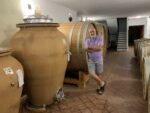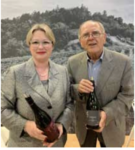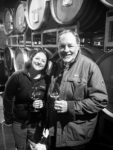SEGUIN MOREAU – “Inspired by the past, built for the future“.
For this new article I propose you to explore one of the most important yet most misunderstood element in the production of wine: THE BARREL.
Above all a little bit of the Seguin Moreau history …
 Seguin Moreau is a company that was born from the merger of two coopers slippers: The Cooperage Seguin and The Coopreage Moreau.
Seguin Moreau is a company that was born from the merger of two coopers slippers: The Cooperage Seguin and The Coopreage Moreau.
In 1959, at the initiative of the company of Cognac REMY MARTIN, the Cooperage Jean Moreau, that was born in 1838, and the Cooperage Alfred Seguin , born in 1870, merged into a single entity.
But this union was already in motion 10 years beforehand. In fact, after the second World War, Jean Moreau, childless, and having been wounded during the war, became unable to resume his job as a master cooper. He approached his friend and colleague Alfred Seguin to share some of their activities to avoid the death of his company.
Historically located in the town of Cognac company, it faced a strong growth in 1972, and moved to the outskirts of the city and settled on a 6 hectare site, where it is still located.
It was closely linked to the Cognac REMY MARTIN it was for a long time its exclusive supplier.
Today SEGUIN MOREAU is THE upscale Cooperage, it has 240 employees worldwide, including 140 in Cognac.
It produces annually about 75,000 tons (combined all countenances: Bordeaux (225L), Burgundy (228L) and vats and casks (> 600L)).
1/3 of production is from the U.S., one third in produced France, and the remaining third from around the world (China, Australia, South America, South Africa, rest of Europe … etc).
Its main site is in Cognac in the Charente area but it has other workshops / offices in Burgundy, Dordogne (where is its stave mill), but also in Bordeaux, in the USA (California and Missouri), and in Australia.
Manufacturing:
Well, as we have already explained it in a previous article (Nadalié) I will focus less on the steps but more on the choice of wood.
 The first step is one of the most important ones, because it involves the selection of the trees auctioned by the NFB. Two wood buyers are responsible for identifying the trees and the selection of parcels.
The first step is one of the most important ones, because it involves the selection of the trees auctioned by the NFB. Two wood buyers are responsible for identifying the trees and the selection of parcels.
Several factors affect the choice of wood: the absence of knots, wood grain, “righteousness” of the tree but also the flavors that will reveal later (mixture of the variety of tree, soil, but also the drying conditions).
Manufacturing “Made in SEGUIN MOREAU” is a subtle blend of three characteristics: “tradition”, “modernity” and “attention” paid to each step of the birth of a barrel.
After the slot staves of wood logs by the stave, the wood is sent to the workshop of Cognac, there it remains 15 days under greenhouse to avoid any influence climate.
During this 15 day period the timber is scanned, if it matches the selection criteria, the wood is preserved otherwise it is returned to the stave.
Once the wood is “accepted” it leaves the park to stay in maturation, drying in open air for 18 to 24 months (on average).
Leaching of wood:
 During the first 45 days the wood will be subject to a very specific watering cycle: 45 minutes of spraying (purified water) and soak for 2 hours. (On the picture you can see the tannins extracted from wood).
During the first 45 days the wood will be subject to a very specific watering cycle: 45 minutes of spraying (purified water) and soak for 2 hours. (On the picture you can see the tannins extracted from wood).
Regarding the other steps, it is actually almost the same as in this article (click here), except for the heating.
SEGUIN MOREAU is the inventor of “bousinage” or second heating whose goal is not to allow bending of the staves to form the barrel, but to reveal the organoleptic qualities of wood.
In addition to traditional wood heaters (light, medium, high), SEGUIN MOREAU has developed a heater called “AQUAFLEX” which involves soaking the barrel in water at 60 ° before being heated. This allows a greater respect for the delicate wood and therefore a better preservation of their flavors.
 In terms of quality control, in addition to the traditional scalding (simultaneous spraying of hot water and air pressure) a second test is added. Indeed, once the barrel is finished, a hose connected to the drain (pierces the barrel) propels pressurized air to test the tightness of the drum.
In terms of quality control, in addition to the traditional scalding (simultaneous spraying of hot water and air pressure) a second test is added. Indeed, once the barrel is finished, a hose connected to the drain (pierces the barrel) propels pressurized air to test the tightness of the drum.
In terms of large containers is all handmade. Indeed every room, every application is different and given the size of containers it is impossible to mechanize any such step as is done for sanding or cutting parts of funds barrels.
ICONE of Seguin Moreau, what is it?
 The process ICONE is the result of 15 years of research whose early years were done in collaboration between SEGUIN MOREAU and the University Bordeaux I. It consists of chemical analysis of wood to determine the flavors and structure that will bring the wine.
The process ICONE is the result of 15 years of research whose early years were done in collaboration between SEGUIN MOREAU and the University Bordeaux I. It consists of chemical analysis of wood to determine the flavors and structure that will bring the wine.
This is what is called the “Potential Oenological” wood, so the capacity of oak woodland to generate an accurate profile of a specific category of wine.
Specifically, how does this goes?
When machining the staves, samples are taken and reduced to sawdust and then analyzed by a machine to reveal what it will bring wood to the wine there. The wood that has the same characteristics is grouped together to form homogeneous barrels in terms of the final tannic and aromatic contribution to the product.
This allows a better selection of wood quality, and greater assurance when the contributions of the wine barrel.
 For the anecdote, there was a decade when the Charente region was passing through a drought … so bad that the crayfish which usually remains in the waters of the Charente ascended the drain leachate from the wood and invaded the park wood maturation … an exceptional show for a cooperage!
For the anecdote, there was a decade when the Charente region was passing through a drought … so bad that the crayfish which usually remains in the waters of the Charente ascended the drain leachate from the wood and invaded the park wood maturation … an exceptional show for a cooperage!
Tasting time:
Yes I know, some “tasting” in an article on the barrel is quite amazing and you should probably ask yourself “but what he has tasted? Wood? ”
At the end of the day I had the pleasure to taste and then compare the same grape wines, from a single plot of the same property …. That were TOTALLY IDENTICAL wines at the base, but were nectars that were raised in different types of barrels.
What better way to feel the importance of the barrel for wine?
 Chardonnay 2011 Limoux (South of France) spent its process in barrels (225L therefore Bordelaise) French oak heater Aquaflex (barrel immersed in water at 60 ° before being heated): Delicate nose typical of chardonnay, a nectar sweet in the mouth releasing flavors of dried yellow fruit, mandarin and lemon verbena … a sweet wine.
Chardonnay 2011 Limoux (South of France) spent its process in barrels (225L therefore Bordelaise) French oak heater Aquaflex (barrel immersed in water at 60 ° before being heated): Delicate nose typical of chardonnay, a nectar sweet in the mouth releasing flavors of dried yellow fruit, mandarin and lemon verbena … a sweet wine.
- Chardonnay 2011 Limoux (South of France) spent its process in barrels (225L therefore Bordelaise) French oak, classical heating (central heating wood): A more acidic wine, with aromas typical of Chardonnay but also aromas of toast, toast, peanut and cashew nuts.
- Merlot Tannat 2010 Domaine Chiroulet (Côtes de Gascogne) spent 2 years old in barrels of French oak 225L: A mineral that gives off wine aromas of violets but also of cassis and blackberry with good maturity. A slightly tannic wine.
 Merlot Tannat 2010 Domaine Chiroulet (Cote de Gascogne) spent its process in new barrels of French oak 225L: A nectar that is more aromatically complex also exhibiting aromas of cassis and blackberry with notes vegetable, spice, toast and almond. A Mineral one, but still a wine more tannic than the last.
Merlot Tannat 2010 Domaine Chiroulet (Cote de Gascogne) spent its process in new barrels of French oak 225L: A nectar that is more aromatically complex also exhibiting aromas of cassis and blackberry with notes vegetable, spice, toast and almond. A Mineral one, but still a wine more tannic than the last.
- Merlot Tannat 2010 Domaine Chiroulet (Côtes de Gascogne) spent its process in new barrels of American oak 225L: A wine with a nose of tobacco, leather and coconut. This wine’s aromas of wood do not come in addition to the flavors of the grape / terroir but a bit obscure. That is to say that the fruit is no longer the first thing that one feels while tasting (the notes of cassis and blackberry do not disappear, they are just less present). A wine that does not immediately produce spicy notes, but that reveals the evolution and oxygenation.
 Cognac brandy to 70% before reduction happened in French oak barrels, coarse, strong heating: (right now I have to admit that the Cognac as unfinished … so it’s pretty … “strong” in the mouth 🙂 ). A Cognac amber color like some aged rums. It reveals aromas of vanilla and orange peel together with a light touch caramelized. XO Cognac a kind, so that custody and develop these qualities later than the following Cognac.
Cognac brandy to 70% before reduction happened in French oak barrels, coarse, strong heating: (right now I have to admit that the Cognac as unfinished … so it’s pretty … “strong” in the mouth 🙂 ). A Cognac amber color like some aged rums. It reveals aromas of vanilla and orange peel together with a light touch caramelized. XO Cognac a kind, so that custody and develop these qualities later than the following Cognac.
- Cognac brandy to 70% before reduction its process happened in French oak barrels, fine grained, light toast: A spirit to being lighter colored and more aromatic but less tannic than the last. This nectar has aromas of raisin, orange blossom and tea. In the end it approaches a Cognac VSOP Cognac therefore a ready to drink but will benefit from aging.
Thanks to Nicolas Mahler-Besse, Elise Peeters, Andrei Prida and Silvana García-Fakih for their time and for this wonderful day.
Have a Good week!
Jonathan Choukroun Chicheportiche
SEGUIN MOREAU cooperage
Website
Facebook
Head Office Address: ZI Merpins, BP94, 16103 COGNAC



